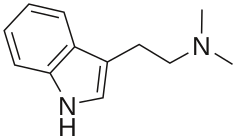Empathogen
This article needs additional citations for verification. (January 2015) |
| Part of a series on |
| Psychedelia |
|---|
 |
The terms empathogen and entactogen are used to designate a class of psychoactive drugs that produce experiences of emotional communion, oneness, relatedness, emotional openness—that is, empathy or sympathy—as particularly observed and reported for experiences with MDMA (ecstasy). This class of drug is distinguished from the classes of hallucinogen or psychedelic, and amphetamine or stimulant. Major members of this class include MDMA, MDA, MDEA, MDOH, MBDB, 6-APB, methylone, mephedrone, αMT, and αET, among others. Most entactogens are phenethylamines and amphetamines, although several, such as αMT and αET, are tryptamines. When referring to MDMA and its counterparts, the term MDxx is often used (with the exception of MDPV). Entactogens are sometimes incorrectly referred to as hallucinogens or stimulants, although many entactogens exhibit psychedelic or stimulant properties as well.[citation needed]
Etymology
The term empathogen, meaning "generating a state of empathy", was coined in 1983–84 independently by Ralph Metzner and David E. Nichols as a term to denote a therapeutic class of drugs that includes MDMA and phenethylamine relatives.[1] Nichols later rejected this initial terminology and adopted, instead, the term entactogen, meaning "touching within", to denote this class of drugs, asserting a concern with the potential for improper association of the term empathogen with negative connotations related to the Greek root πάθος páthos ("suffering").[2] Nichols also thought the original term was limiting, and did not cover other therapeutic uses for the drugs that go beyond instilling feelings of empathy.[3] The hybrid word entactogen is derived from the roots en ([within] Error: {{Lang-xx}}: text has italic markup (help)), tactus (Template:Lang-la) and -gen ([produce] Error: {{Lang-xx}}: text has italic markup (help)).[2] Neither term is dominant in usage, and, despite their difference in connotation, they are essentially interchangeable, as they refer to precisely the same chemicals.
Psychological effects
Both terms adopted and used in naming the class of therapeutic drugs for MDMA and related compounds were chosen with the intention of providing some reflection of the reported psychological effects associated with drugs in the classification and distinguishing these compounds from classical psychedelic drugs such as LSD, mescaline, and psilocybin and major stimulants, such as methamphetamine and amphetamine.[3] Chemically, MDMA is classified as both a substituted phenethylamines (which includes compounds that are psychedelic drugs, such as mescaline) and as a substituted amphetamines (which includes compounds well known to be stimulant drugs). While chemically related both to psychedelics and stimulants, the psychological effects experienced with MDMA were reported to provide obvious and striking aspects of personal relatedness, feelings of connectedness, communion with others, and ability to feel what others feel—in short an empathic resonance is consistently evoked."[4] While psychedelics like LSD may sometimes yield effects of empathic resonance, these effects tend to be momentary and likely passed over on the way to some other dimension or interest. In contrast, the main characteristic that distinguishes MDMA from LSD-type experiences is the consistency of the effects of emotional communion, relatedness, emotional openness—in short, empathy and sympathy.[3]
Examples
The chemicals below have a varying degree of entactogenic effects. Some of the chemicals have a minimal[clarification needed] entactogenic effect while others may have a strong entactogenic effect. These substances possess other effects including serenic effects, stimulant effects, antidepressant effects, anxiolytic effects, and psychedelic effects.[citation needed]
Phenethylamines
Amphetamines
- 5-(2-Aminopropyl)-2,3-dihydro-1H-indene (5-APDI, IAP)
- 6-(2-Aminopropyl)benzofuran (6-APB) (benzofury)
- 5-(2-aminopropyl)benzofuran (5-APB)
- Methylbenzodioxolylbutanamine (MBDB)
- Methylenedioxyamphetamine (MDA)
- Methylenedioxyethylamphetamine (MDEA)
- Methylenedioxymethamphetamine (MDMA) (ecstasy)
- Methylenedioxyhydroxyamphetamine (MDOH)
Cathinones
- Mephedrone
- 3-Methylmethcathinone (3-MMC)
- Methylone
Tryptamines
- α-Ethyltryptamine (αET)
- α-Methyltryptamine (αMT)
Aminoindanes
- 5-Iodo-2-aminoindane (5-IAI)
- Methylenedioxyaminoindane (MDAI)
References
- ^ Holland, edited by Julie; Metzner, Ralph; Adamson, Sophia (2001). Ecstasy : the complete guide ; a comprehensive look at the risks and benefits of MDMA. Rochester, Vt: Park Street Press. p. 182. ISBN 0-89281-857-3.
{{cite book}}:|first1=has generic name (help) - ^ a b Nichols, D. (1986). "Differences Between the Mechanism of Action of MDMA, MBDB, and the Classic Hallucinogens. Identification of a New Therapeutic Class: Entactogens". J. Psychoactive Drugs. 18 (4): 305–13. doi:10.1080/02791072.1986.10472362.
- ^ a b c Nichols, D; Yensen, R; Metzner, R; Shakespeare, W (1993). "The Great Entactogen - Empathogen Debate". Newsletter of the Multidisciplinary Association for Psychedelic Studies MAPS. 4 (2): 47–49. Retrieved 6 January 2015.
- ^ Metzner, Ralph (1993). "Letter from Ralph Metzner". Newsletter of the Multidisciplinary Association for Psychedelic Studies MAPS. 4 (1). Retrieved 8 January 2015.
Bibliography
- Nichols, D.E., Hoffman, A.J., Oberlender, R.A., Jacob P 3rd & Shulgin A.T. Derivatives of 1-(1,3-benzodioxol-5-yl)-2-butanamine: representatives of a novel therapeutic class 1986 J Med Chem 29 2009-15
